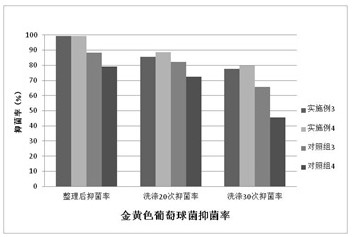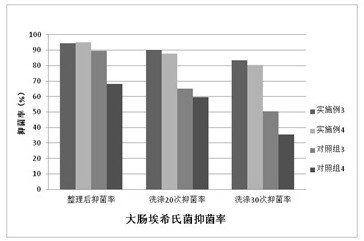Antibacterial finishing agent for silk fabrics and preparation method thereof
An antibacterial finishing agent and fabric technology, applied in animal fibers, fiber treatment, textiles and papermaking, etc., can solve the problems of silk fabrics easily breed bacteria and fungal contamination, and achieve the effect of low cost, mild reaction conditions and reduced impact
- Summary
- Abstract
- Description
- Claims
- Application Information
AI Technical Summary
Problems solved by technology
Method used
Image
Examples
Embodiment 1
[0028] Example 1: Preparation and activity determination of antimicrobial peptides
[0029] (1) Design and preparation of antimicrobial peptides
[0030]According to the mechanism of action of Cecropin P1 and the structural site of antibacterial activity, through the structural design of the original Cecropin P1 antimicrobial peptide whose sequence is SEQ ID No: 2, during the design process, the antibacterial peptide domain of Cecropin P1 was maintained, and the antibacterial peptide domain of Cecropin P1 was increased. Positively charged arginine (R) and lysine (K) make it better adsorbed on the surface of silk materials, and also better adsorbed on the surface of negatively charged bacteria. Its antibacterial activity was also enhanced. The sequence of the redesigned antimicrobial peptide is SEQ ID No:1. Among them, the amino acid sequence of SEQ ID No: 1 is: SWLSKTAKKLEKRAKKRKSRGIAIAIQGGRR; the amino acid sequence of the original Cecropin P1 antimicrobial peptide is SEQ I...
Embodiment 2
[0038] Embodiment 2: Preparation and antibacterial activity detection of small molecular weight chitosan
[0039] (1) Preparation of small molecular weight chitosan
[0040] Step 1, the dissolving of high molecular weight chitosan: the viscosity average molecular weight is 3.0 * 10 5 100g of high molecular weight chitosan with a deacetylation degree of 90.5% is dissolved in an acetic acid solution with a volume fraction of 22%, to obtain a chitosan solution with a mass volume concentration of 25% (w / v);
[0041] Step 2, the degradation of high molecular weight chitosan: the chitosan solution prepared in step 1 was subjected to ultrasonic treatment twice, the temperature of the first ultrasonic treatment was 45°C, the time of ultrasonic treatment was 4 hours, and the ultrasonic power was 600W ; The temperature of the second ultrasonic treatment is 20°C, the ultrasonic treatment time is 5 hours, and the ultrasonic power is 200W, and the small molecule chitosan with an average r...
Embodiment 3
[0053] Embodiment 3: the preparation of antibacterial finishing agent
[0054] Step 1: Weigh antimicrobial peptides, small molecular weight chitosan and tea polyphenols by weight, dissolve small molecular weight chitosan with 5% (v / v) concentration of acetic acid solution at 40°C, then cool to room temperature, add The antimicrobial peptide and tea polyphenols were stirred and dissolved to obtain solution A;
[0055] Step 2, adding Tween 80 into solution A, stirring and mixing, adjusting the pH value to 3.0-4.0 to obtain solution B;
[0056] Step 3: Gradually add a sodium tripolyphosphate solution with a concentration of 5g / L dropwise to the solution B in step 2 at room temperature, and stir at a high speed while adding dropwise, until the sodium tripolyphosphate solution is completely dripped, and the present invention is obtained. The antibacterial finishing liquid.
[0057] Wherein in the solution A of step 1, the concentration of antimicrobial peptide is 62.5mg / L; the co...
PUM
| Property | Measurement | Unit |
|---|---|---|
| concentration | aaaaa | aaaaa |
| diameter | aaaaa | aaaaa |
| diameter | aaaaa | aaaaa |
Abstract
Description
Claims
Application Information
 Login to View More
Login to View More - R&D
- Intellectual Property
- Life Sciences
- Materials
- Tech Scout
- Unparalleled Data Quality
- Higher Quality Content
- 60% Fewer Hallucinations
Browse by: Latest US Patents, China's latest patents, Technical Efficacy Thesaurus, Application Domain, Technology Topic, Popular Technical Reports.
© 2025 PatSnap. All rights reserved.Legal|Privacy policy|Modern Slavery Act Transparency Statement|Sitemap|About US| Contact US: help@patsnap.com


